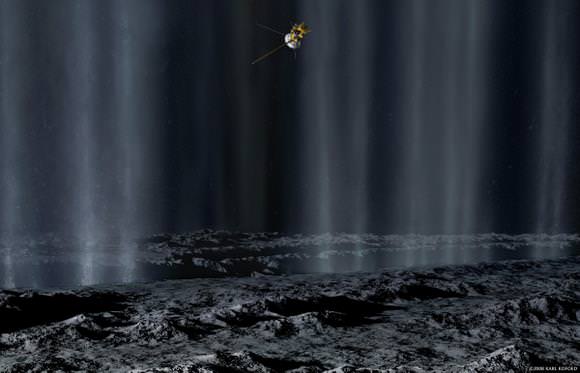[/caption]
Observations from two instruments on the Cassini spacecraft shows the moon Enceladus leaves a complex pattern of ripples and bubbles in its wake as it orbit Saturn. The ringed planet’s magnetosphere is filled with electrically charged particles (plasma) originating from both the planet and its moons, and as Enceladus plows through the plasma “spiky” features form that represent bubbles of low energy particles, said Sheila Kanani who led a team of scientists from University College, London who discovered the phenomenon.
Cassini has made nine flybys of the icy, geyser-filled moon Enceladus (Saturn’s sixth-largest moon) since 2005. The closest of these have taken the spacecraft’s suite of instruments just 25 km from Enceladus’s surface, which scientists believe conceals a saline ocean. Heated vents at the south pole of the moon release a plume of material, consisting mainly of icy grains and water vapour, into space.
Measurements from the Cassini Plasma Spectrometer (CAPS) and the Magnetospheric IMaging Instrument (MIMI) show that both the moon and its plume are continuously soaking up the plasma, which rushes past at around 30 kilometers per second, leaving a cavity downstream. In addition, the most energetic particles which zoom up and down Saturn’s magnetic field lines are swept up, leaving a much larger void in the high energy plasma. Material from Enceladus, both dust and gas, is also being charged and forming new plasma.
The mysterious spiky features in the CAPS data shows a complex picture of readjustment downstream from Enceladus.
“Eventually the plasma closes the gap downstream from Enceladus but our observations show that this isn’t happening in a smooth, orderly fashion. We are seeing spiky features in the plasma that last between a few tens of seconds and a minute or two. We think that these might represent bubbles of low energy particles formed as the plasma fills the gap from different directions,” said Kanani. Since Cassini arrived at Saturn, it has been building up a picture of the vital and unexpected role that Enceladus plays in Saturn’s magnetosphere.
“Enceladus is the source of most of the plasma in Saturn’s magnetosphere, with ionised water and oxygen originating from the vents forming a big torus of plasma that surrounds Saturn. We may see these spiky features in the wake of Saturn’s other moons as they interact with the plasma but, to date, we have only studied Enceladus in sufficient detail,” said Kanani.
She presented her results at the Royal Astronomical Society’s National Astronomy Meeting in Glasgow, Scotland this week.
Source: RAS NAM


I wonder if certain individuals: (a) seriously misunderstand the mainstream opinion to which they believe that they are objecting; (b) claim that their ideas are being suppressed, typically by secret intelligence organizations, mainstream science, powerful business interests, or other groups which, they insinuate, are terrified by the possibility of their allegedly revolutionary insights becoming widely known; (c) think there are conspiracies about “hidden knowledge”; (d) overestimate their own knowledge and ability, and underestimate that of acknowledged experts!